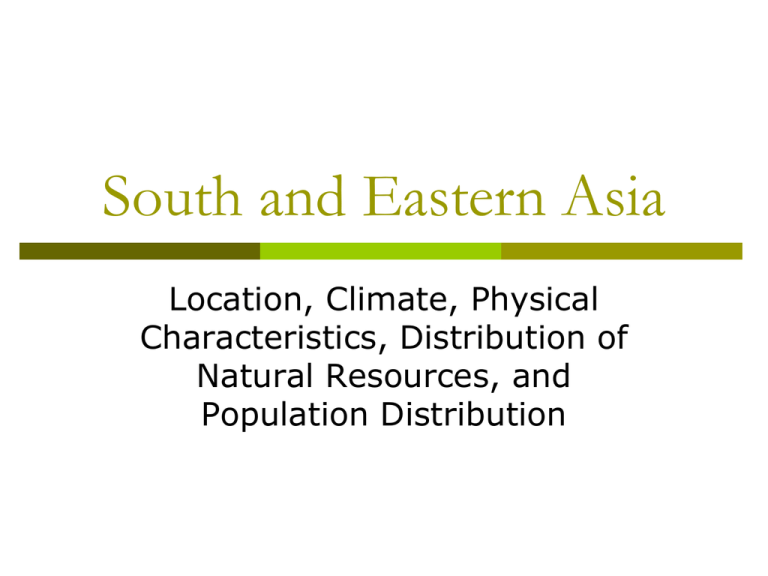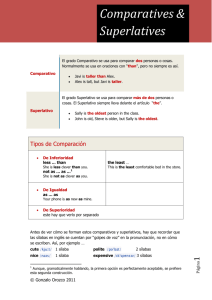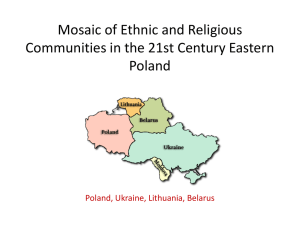South and Eastern Asia Lesson
advertisement

South and Eastern Asia Location, Climate, Physical Characteristics, Distribution of Natural Resources, and Population Distribution Standards SS7G11 The student will explain the impact of location, climate, physical characteristics, distribution of natural resources, and population distribution on Southern and Eastern Asia. a. Describe the impact climate and location has on population distribution in Southern and Eastern Asia. b. Describe how the mountain, desert, and water features of Southern and Eastern Asia have affected the population in terms of where people live, the types of work they do, and how they travel. Asia Has It All Asia has a great variety of landforms and climates. A large part of Asia is desert, yet much of southern and southeastern Asia receives tremendous amounts of rain each year. Massive mountain ranges rise in the north, while steamy rain forests lie low in the south. Lots and Lots of People! More than one-third of all the people in the world live in China and India! Most Asians live in rural areas, farming the land to provide food for their families. About 90 percent of China’s people are concentrated in the plateaus, plains, and river valleys of the eastern third of the country where fertile soil and plentiful rain are found. Close to 75 percent of India’s population lives in more than 500,000 villages. Since about half of India’s land is arable (land that is suitable for growing crops), most Indians work in agriculture. Solutions to Population In China they have instituted the “onechild-per-family policy of 1979”. This states that any couple that has only one child will receive economic and educational benefits, while couples that have more than one child will have to pay fines. About half of Vietnam’s people are farmers, living in the fertile deltas of the Mekong and Red Rivers and growing rice, coffee, fruits, and vegetables. Likewise, in Thailand, people cluster around fertile river areas to grow rice and other crops. Even in highly industrialized Japan, most of the people are concentrated in small lowlands where the largest cities are located. Continued The population is much lower in the rugged mountains of China and Japan. Here the winters are long and very cold, and the summers are short. The region of Tibet, in southwestern China, has a population density of only 2 persons per square mile! The desert areas of China also have very few inhabitants because of the harsh climate. Lots and Lots of People Quick Quiz! 1. 2. 3. 4. 5. 6. 7. About one third of the world’s population lives in these two countries: ___________ and ______________. About 75 percent of India’s people lives in ___________. In Vietnam many people farm along these rivers: ___________ and ____________. About 90 percent of Chinese live in the ____________ part of the country. Since about half of India’s land is arable, most Indians work in ____________. Mountain regions of Asia have a _________________ population than other areas. ___________________is a highly industrialized country. Word Wall: Villages eastern China agriculture Japan Red Mekong India lower Crowded Cities Many Asian cities have huge populations. In fact, twelve of the 20 most populated unban areas in the world are located in Southern and Eastern Asia. In Chinese cities like Beijing and Shanghai, the population can exceed almost 6,000 people per square mile. Business is booming in China’s cities, and employment opportunities abound. Much of Japan’s population is also crowded into cities. Tokyo is the most crowded urban area in the world with a population density of 33,000 people per square mile. Land in Tokyo is precious and very expensive. Crowded Cities 2 In India, information technology and telecommunications are growing industries, providing many employment opportunities in cities like Mumbai and Kolkata. Unfortunately, many people living in Asian cities are very poor and live in extremely crowded, unsanitary conditions. Half of the island nations of Indonesia’s population lives on Java. City dwellers find employment in industry and technology. There are seaports and oil centers, plus farms and coffee plantations. In North Korea, about one-third of the people work in agriculture, while the rest of the people work in industry and services Essential Skills Urban Agglomerations An urban agglomeration is a city plus all the smaller towns and growth around it. Tokyo, Japan 35 million Mexico City, Mexico 18.7 million New York, NY 18.3 million Sao Paulo, Brazil 17.9 million Mumbai, India 17.4 million Delhi, India 14.1 million Kolkata (Calcutta), India 13.1 million Buenos Aires, Argentina 13 million Shanghai, China 12.8 million Jakarta, Indonesia 12.3 million Los Angeles, CA 12 million Dhaka, Bangladesh 11.6 million Osaka, Japan 11.2 million Rio de Janeiro, Brazil 11.2 million Karachi, Pakistan 11.1 million Beijing, China 10.8 million Cairo, Egypt 10.8 million Manila, Philippines 10.4 million Paris, France 9.8 million Seoul, South Korea 9.7 million Essential Skills Questions 1. 2. 3. 4. 5. 6. 7. 8. How many of the world’s top 20 urban agglomerations are in Asia? How many of the top ten are in India? What is the most crowded urban area in the world? How many more people live in Tokyo than Jakarta? Because there are more employment opportunities in cities, the population of Delhi will probably_______________. The government of China wants families to have only one child. How might that affect the future population of Shanghai? What is the most crowded urban area in the United States? What is the most crowded urban area in South America?











